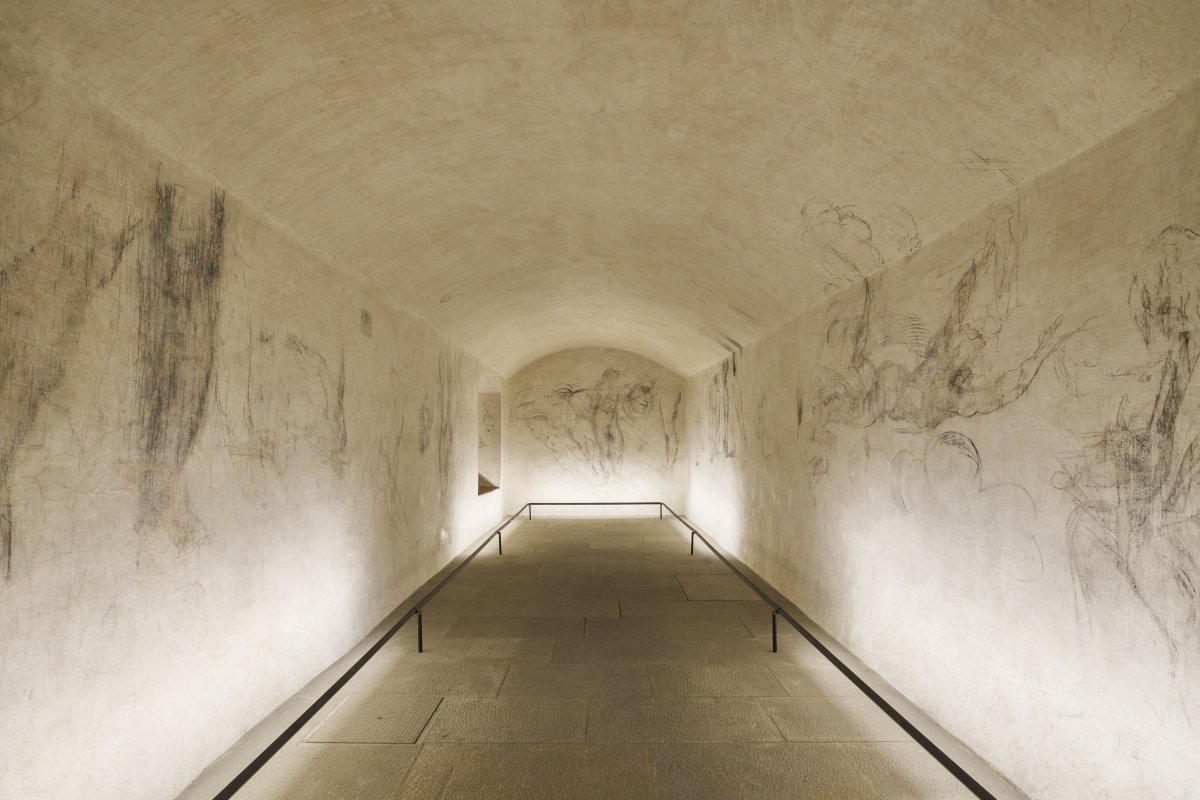ISABEL RUBIO ARROYO | Tungsteno
Fifty years ago, a secret room was discovered where Michelangelo once hid. For decades it has remained closed to the public. Then, in 2023, the Bargello Museum in Florence decided to allow a few lucky people to visit it. What precious treasures are hidden inside? Drawings and sketches of anatomy, faces and poses, mostly by the famous Italian sculptor.
A treasure found by chance
In 1975, Paolo Dal Poggetto, then director of the Medici Chapels Museum in Florence, asked the restorer Sabino Giovannoni to carry out some cleaning tests in a narrow corridor under the apse of the New Sacristy inside the museum. The elongated space, 10 metres long and three metres wide, had been discovered when Dal Poggetto and his colleagues were looking for a suitable location for a new exit to the museum. But when Giovannoni did some tests on the walls, he found something unexpected under two layers of plaster: a series of wall drawings of figures of various sizes, sketched with charcoal and chalk.
"This room had been used as a coal depot until 1955 and then it was left unused, remaining closed and forgotten for decades, under a trapdoor completely covered by cupboards, furniture and piled-up furnishings," says the Bargello Museum. Poggetto attributed most of the drawings to Michelangelo. He hypothesised that the artist had hidden there for about two months in 1530 to take refuge from the vengeance of Pope Clement VII, who was angry with him for having been in charge of the fortifications during the brief period of Republican rule.
The drawings were discovered by chance thanks to a cleaning carried out in 1975. Credit: Bargello Museum
Walls as canvases
"Naturally, Michelangelo was afraid and he decided to stay in the room," Monica Bietti, the art historian in charge of the Medici Chapels, told National Geographic magazine. The drawings, according to this hypothesis, would have been made during the artist’s period of "self-imprisonment", when he used the walls of the small room to sketch out some of his projects. These include works from the New Sacristy, such as the legs of Giuliano de' Medici, Duke of Nemours, and projects attributable to other sculptures and paintings.
For Massimo Osanna, Director General of Museums of Italy, it is "a place of extraordinary charm, but very delicate due to the location of the narrow room in the museum's itinerary and the protection of the charcoal drawings on the walls." For this reason, visits are conducted in a controlled manner: in small groups of four people and a maximum of 100 people per week. "The limited number of visitors per time slot is due to the need to alternate the period of exposure to LED light with prolonged periods of darkness," says the museum.
The room first opened to the public in 2023. Credit: Bargello Museum
Are all the drawings by Michelangelo?
It is impossible to confirm with absolute certainty that Michelangelo is the author of all the drawings on the walls. In fact, not all the figures show "the same sustained qualitative tension of Michelangelo's work," according to the Bargello Museum in Florence. William Wallace, a Michelangelo scholar and professor at Washington University in St. Louis, believes that Michelangelo was too important a figure to have holed up in such a cramped space. While he concedes that some of these drawings may be Michelangelo originals, he suggests that others are probably sketches made by his assistants during breaks in their work.
What is certain is that it is a unique place. "This very small room is truly unique for its extraordinary evocative potential. Its walls seem to barely contain numerous sketches of figures, most of them monumental in size, traced with markings that testify to a great clarity of design," says Francesca de Luca, curator of the Medici Chapels Museum. Although we can’t be 100% sure of the identity of the artist or artists responsible for all the sketches, some experts are convinced that it was Michelangelo. One such expert is Bietti, who is convinced that Michelangelo "was a genius." "What can he do there? Just draw."
· — —
Tungsteno is a journalism laboratory to scan the essence of innovation.
